Most Internet users have searched for answers to specific questions.
- 83% of users have done a search online to answer a specific question, according to our latest survey on the subject in September 2002.
- The number of those who have used the Internet to answer questions grew 24% from 79 million to 98 million between the fall of 2000 and September 2002.
- English-speaking Hispanic users are among least likely to use the Internet this way.
- There are more searchers among those with higher education levels (college degrees) than among those who completed high school.
- Those with the most experience online and those with broadband connections are more likely than others to do online searches for information on any given day.
The act of using the Internet to answer basic questions is second only to email in its popularity as an online activity and easily one of the most essential functions of the Internet. More than eight out of ten online Americans say they have searched the Web for answers to their questions. That translated into 98 million Americans who had turned to the Web for their queries in September 2002, up from 79 million in late 2000. About a fifth of Internet users or about 22 million people go online on a typical day for this reason, according to our survey in September 2002 (up from 16 million in 2000).
Often one of the first activities that new users try, searching is an important step in how newcomers to the Web come to value the Internet as an everyday reference for finding useful information. Also, it is an important exercise in learning how to sift through the sometimes unreliable or irrelevant information that one can encounter during Web browsing. In the past, we have identified this activity as part of the early “search and learn” mode that allows new users to become comfortable with the fundamental workings and navigation of the Web.31
Internet searching is an umbrella activity that encompasses many of the other more specific activities we ask about. For example, the people who do this activity might also say they use the Internet to look for health information, do research for school, or research a product. These searches might begin by using a general search engine like Google or by navigating directly to a more specialized resource site like WebMD.
When using a search engine, users need not have a specific question in mind, but may simply type a subject or name of interest into the search field. In January 2002, we asked: “Do you ever use an online search engine to help you find information on the Web?” At that time, 85% of Internet users had used search engines and 29% were using these searching tools on a typical day.32 The act of searching the Internet to answer questions appeals equally to men and women. However, over time, men have become increasingly more likely to report that they do these focused searches on a typical day (22% of online men do this on an average day vs. 15% of online women in September 2002).
African-American Internet users have become more likely to conduct Internet searches since we first started polling on this activity. The last time we asked this question, 85% of online blacks said they went online for answers, while 84% of white users said so. In comparison, English-speaking Hispanic Internet users have remained the least likely to search; the portion that says they submit their queries online has consistently been around 73%.33
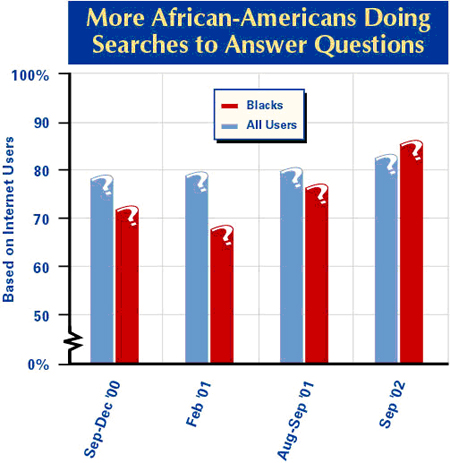
Age is of little import when it comes to posing one’s questions online. All users aged 18-64 have generally been equally as likely to say they have conducted online inquiries to find the answers they need; a little over eight in ten said they did so in September 2002, up slightly from 2000. Online Americans who are 65 and older have been less likely to do Internet searches compared to their younger counterparts. Still, the vast majority of wired seniors have probed their questions online; 7 in 10 wired seniors said they had made these queries in our September 2002 survey.
Other demographics
The higher an Internet user’s level of education, the more likely it is that she has used the Internet to help answer a question. For instance, we found in mid-2002 that 80% of those with high school educations said they had used the Internet to answer questions, compared to 87% of those with a college degree.
Similarly, the more experience online that an Internet user has, the more likely it is he has gone online to answer questions on any given day. In September 2002, 23% of Internet users who had been online for 4 or more years reported searching for answers to specific questions on a typical day, compared to only 4% of those with 1 year or less of online experience who did so.
Having access to a high-speed connection at home can make one’s online searching a more seamless part of everyday life. Our September 2002 data indicate that a higher proportion of broadband users go online for answers and do so more often than dial-up users. Twenty-six percent of home broadband users went online the day prior to the survey to search for an answer to a question they had, while 18% of dial-up users did so.
For more information on Internet searching, please visit the following reports and see appendix:
-
Search Engines: A Pew Internet Project Data Memo https://www.pewresearch.org/internet/Reports/2002/Search-Engines.aspx
-
The Broadband Difference: How online Americans’ behavior changes with high-speed connections at home https://www.pewresearch.org/internet/Reports/2002/The-Broadband-Difference-How-online-behavior-changes-with-highspeed-Internet-connections.aspx
-
New Internet Users: What they do online, what they don’t and implications for the Net’s future https://www.pewresearch.org/internet/Reports/2000/New-Internet-Users.aspx
The vast majority of Internet users have gone online to get news.
- 71% of Internet users have gone online to get the news, according to our survey in December 2002. This represents growth of 50% from 52 million who reported getting news online as of March 2000 to 78 million who had done so, as of December 2002.
- Online men are more likely than online women to get news from the Internet.
- A greater proportion of those with high household incomes and high levels of education have used the Internet to get news compared to those with less income and education.
- Those with high-speed connections at home and those with greater levels of experience online are more likely to do online news searching.
Online newsgathering expands, fueled by major public events
Approximately 78 million Americans had used the Internet to get news as of December 2002. This was up from 52 million who had gotten news online as of March 2000. At that time, 60% of Internet users got news online and in December 2002, 71% had done so. For comparison’s sake, getting news online is more popular than buying a product or looking for health information online. Still, the act of getting news is done by fewer people than the act of researching a product online before buying it, for example.
The frequency of newsgathering also grew steadily over the time we have been conducting surveys. In March 2000, roughly 19 million Americans were getting news online on a typical day. By December 2002, that number had grown to about 29 million.
The Pew Research Center has been tracking Americans’ interest in online news since 1995. According to a survey conducted between May and June of 1995, 6% of Internet users were getting news off the Web every day, while 30% said they read news online at least weekly.
Major public events have repeatedly been the impetus that has expanded online news consumption to new arenas. For example, Campaign 2000 established the Internet as a key source for timely election news and information. We reported in December of that year that one-third of the online population had gone online specifically for election news during the 2000 campaign. In 2001, in the days immediately following the events of September 11th, many Americans relied on the Web for the latest coverage, and the percentage of all Internet users who got news online on a typical day tilted up from 22% (in August) to 27%. And by March 2003, in the days leading up to the Iraq war (March 12-19), the online news audience jumped from 26% of the Internet population on a typical day in February 2003 to 37% on a typical day at the dawn of the war.
Men with Internet access have been more fervent online news users compared to women, but that gap narrowed most noticeably in the period following September 11th and appeared to be closing again over the course of fall 2002. In December, 73% of online men said they had used the Internet at some point to get news, while 69% of online women had done so. Thirty percent of male users got news on a typical day in December compared to 22% of women. However, female Internet users’ demand for news has grown more than men’s.
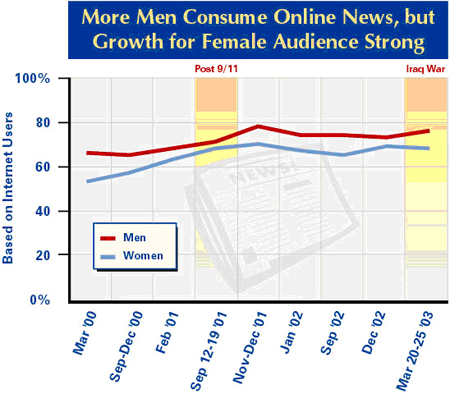
Likely reflecting the impact of the September 11th attacks, all of the various racial groups expressed peak activity in seeking news online during the late months of 2001. In contrast to what we have found with other information-gathering activities, online whites have not had greater levels of overall experience with online news-seeking when compared to online African-Americans and English-speaking Hispanics. By November 2002, for instance, 65% of online whites had sought news online compared to 76% of online African-Americans and 68% of online Hispanics.
While online Americans aged 30-49 have consistently been the most likely to seek news online compared to other age groups, users aged 50-64 and those aged 18-29 have exhibited the most growth in news seeking over the course of our research. Seventy-four percent of Internet users in the 50-64 age group had gone online for news, according to our December 2002 survey, compared to just 57% who had done so in March 2000. News seekers aged 18-29 also grew very rapidly; 72% sought news in December up from 56% in March. Wired seniors and users who are 30-49 have shown less variation in their news-seeking habits. However, it is important to note that this activity is among the most popular online pastimes for users aged 65 and over.
Other demographics
As is the case with many information-gathering activities, Internet users with higher education levels and greater household incomes are more likely than others to have sought news online. For example, in December 2002, 78% of users with a college degree had gotten news online, while just 64% of those with a high school degree had done so. Comparatively, the differences among the various economic groupings of users were less stark; 77% of those with household incomes of $75,000 or more had sought news online, and 67% of those with incomes under $30,000 had done so.
Internet veterans are generally more likely to seek news than users with less experience online. In December, half of new users with less than one year of experience had sought news online, compared to three-quarters of users with 4-5 years of experience. Similarly, those who have home broadband access are more likely to be online news-seekers compared to users who have dial-up connections; 81% of high-speed users had sought news online in our December 2002 survey, compared to 70% of those with dial-up access.
For more information on online news seeking and use, please see the following Pew Internet Project reports:
-
The Internet and the Iraq War: How online Americans have used the Internet to learn war news, understand events, and promote their views: https://www.pewresearch.org/internet/Reports/2003/The-Internet-and-the-Iraq-war.aspx
-
The Commons of the Tragedy: How the Internet was used by millions after the terror attacks to grieve, console, share news, and debate the country’s response https://www.pewresearch.org/internet/Reports/2001/The-Commons-of-the-Tragedy-How-the-Internet-was-used-by-millions-after-the-terror-attacks.aspx
-
Internet Election News Audience Seeks Convenience, Familiar Names https://www.pewresearch.org/internet/Reports/2000/Internet-Election-News-Audience-Seeks-Convenience-Familiar-Names.aspx
- Olympics Online: The Old Media Beat the New Media https://www.pewresearch.org/internet/Reports/2000/Olympics-Online.aspx
There has been a surge in use of the Internet for health or medical information.
- 66% of Internet users have said “yes” when we asked the simple question: Do you ever use the Internet to get health or medical information? However, when we asked about 16 specific kinds of health searches (seeking diet and fitness information, material about health insurance, mental health information, etc.), the percentage of Internet users who had done health searches came to 80% in the December 2002 survey.
- The number of those who have done health searches online grew at least 59%, from a figure of 46 million in March 2000 to 73 million in December 2002.
- Online women are much more likely than online men to have done health searches using the Internet.
- Online whites are generally more likely than online African-Americans and English-speaking Hispanic users to say they have searched for health information online.
- Young adult users are the least connected to health information compared to older users, and wired seniors’ interest in online health information has jumped markedly in recent years.
Two in three Internet users search for health information online
The Internet has increasingly become an important source of health-care and medical information for the majority of online American adults. Those health seekers who turn to the Internet as a reference for health information grew substantially from 54% in March 2000, to 66% of the online population in December 2002. This is a conservative measure of the online health-seeking population because it only accounts or people who said “yes” to our simple question: Do you ever use the Internet to get health or medical information? When we probed more extensively on a variety of types of health searches, we found that 80% of Internet users had done some kind of health searches online. The analysis in this report will focus on those who answered the simple question, not those who said “yes” to items in our battery of questions.
The act of doing medical research online is hardly an everyday thing. Except for those who are chronically ill, most people only need to access medical information the few times a year (or even less frequently) that they or someone they love is ill. The number of those who seek health information on a typical day increased marginally — from 6 million to 7 million people — and their representation within the online population held constant at around 7%.
The efficiency and convenience of online health searches are both factors that have influenced the overall growth of this activity. In “Vital Decisions: How Internet users decide what information to trust when they or their loved ones are sick,” we reported that the majority of health seekers (82%) were successfully finding the information they needed online “most of the time” or “always.”34 Further, most found it quickly—often in under an hour.
The Internet has become a critical health research tool for many, but it is far from replacing the traditional doctor/patient relationship altogether. Health seekers consult the Web on an as-needed basis, and very few go online in lieu of seeing a doctor. Instead, most use the information they find online to supplement their offline care.
In “Vital Decisions,” we also reported that the number-one reason health seekers went online was to look for advice on someone else’s behalf. Whether it was a friend, spouse, child, or parent, 81% of health seekers said they went online because someone they knew was diagnosed with a medical condition. In comparison, 58% of health seekers had gone online in response to being diagnosed with a new health problem of their own. In our December 2002 survey, 70% of online parents had sought health information online, compared to 64% of non-parents.
Women are considerably more likely than men to search for medical and health answers online. Over time, that gap has become slightly more pronounced; in December 2002, 74% of women had sought health information online, while only 58% of men had done so. These gender differences are not as consistently well-defined with those who look for health information on an average day, but overall, women are more avid “daily” health seekers.
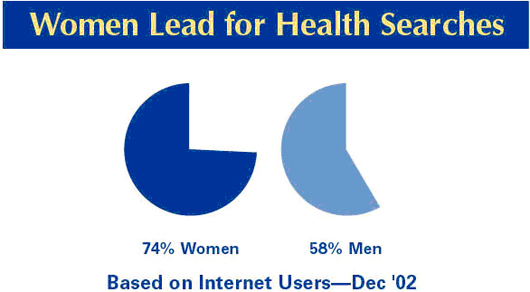
While racial differences in accessing health information have fluctuated over the course of our research, English-speaking Hispanics and African-Americans who are Internet users have often been less likely than whites to look for health information online. However, when we last reported on the demographics of health seekers in July 2003, we found that, when other demographic factors were held constant, race was not a deciding factor in determining the likelihood that one would be health seeker.35 Instead, education levels accounted for much of the variation in experience with health-seeking online. While those with lower levels of education have become more experienced with this activity over time, they still tend to be less likely to research health questions online compared to users with higher educational attainment. Differences according to income have been less pronounced.
Our most recent findings on searching for health information were published in the July 2003 report, “Internet Health Resources.”
Those who are aged 18-29 have been the least connected of all the age groups to health resources online. This is possibly related to the fact that younger Internet users tend to have fewer health problems and therefore have less motivation to seek such information online or elsewhere. Those in the middle-age groups are still the most likely to turn to the Web as a reference for their health concerns, but seniors are catching up with them quickly. While those who are 65 and over generally lag far behind their younger counterparts in most activities, searching for health information online has become dramatically more important for this age group over the course of our research. When we first began measuring this activity in March 2000, a mere 46% of online seniors had sought answers to their health questions online.36 But by the June-July 2002 survey period, that number rose to 74%.
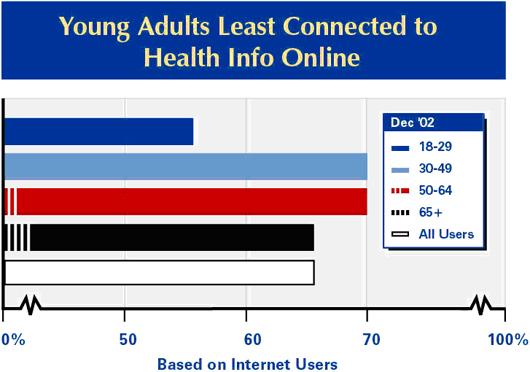
Other demographics
Exposure to health information varies according to the amount of time a user has spent online; those with more years of experience navigating the Web are more likely to delve into health and medical content.
The broadband effect has repeatedly been evident with this activity as well; for example, 74% of home broadband users had searched for health or medical information online at the end of 2002 while just 67% of dial-up users had done so.
For more information on Online Health, please see the following Pew Internet Project reports:
-
Vital Decisions: How Internet users decide what information to trust when they or their loved ones are sick. https://www.pewresearch.org/internet/Reports/2002/Vital-Decisions-A-Pew-Internet-Health-Report.aspx
-
Internet Health Resources: Health searches and email have become more commonplace, but there is room for improvement in searches and overall Internet access https://www.pewresearch.org/internet/Reports/2003/Internet-Health-Resources.aspx
-
Exposed Online: Why the new Federal Health Privacy regulation doesn’t offer much protection to Internet users https://www.pewresearch.org/internet/Reports/2001/Exposed-Online-The-federal-health-privacy-regulation-and-Internet-user-impacts.aspx
-
The Online Health Care Revolution: The Web helps Americans take better care of themselves. https://www.pewresearch.org/internet/Reports/2000/The-Online-Health-Care-Revolution.aspx
Nearly one-third of Internet users look for religious or spiritual information.
- 30% of Internet users have sought religious information online as of November 2002.
- That represents growth of 94%, from 18 million who had sought religious information as of March 2000, to 35 million who had done such searches as of November 2002.
- More online women than online men have done religious searches on the Web.
- African-American users are more likely than other groups to have searched for religious information online, especially African-American women.
Approximately 35 million Americans, or 30% of Internet users, had used the Web as a religious resource when we surveyed the topic in November 2002. That was up significantly from the 21% of Internet users we measured in March 2000 (18 million Americans) and the 25% of Internet users (28 million Americans) who were looking for religious or spiritual information in August–September 2001. However, those who seek religious information on a typical day grew only slightly, from about 3 million to 5 million Americans between 2000 and 2002.
In the past, we have reported extensively on the different things religion surfers do online. Our last report on religious surfing, “CyberFaith: How Americans Pursue Religion Online,” reported that the majority of these “religion surfers” look for information about their own faith (67%), but half also use the Web to research outside of their faith. Similarly, solitary activities like mailing prayer requests and downloading religious music are also very popular pastimes for religion surfers (38% have done each of these activities), while more socially-oriented activities such as seeking spiritual guidance via email (21%) or participating in a religious chat room (10%) have not been as widespread.
Women have been more apt to say they are religion surfers than men, a trend that has become increasingly evident over time. Still, men and women are equally as likely to say they search for religious information on an average day.
In “CyberFaith,” we reported that, according to data from August–September 2001, there were no dramatic differences among the various racial groups of religion surfers. However, the percentage of African-American Internet users who are religion surfers has since grown and it is apparent now that they are more likely than Internet users in other groups to access religious and spiritual material online. Our most recent research on this topic shows that African-American Internet users are twice as likely to seek religious information compared to English-speaking Hispanic Internet users (47% vs. 24%). Comparatively, white Internet users are also much less likely to perform faith-based queries than African-American users; some 28% of online whites have sought religious or spiritual information online.
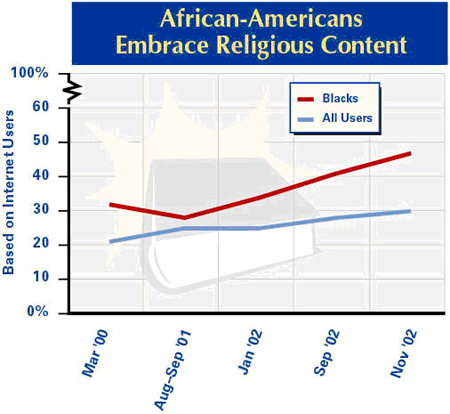
Young adult Internet users (18- to 29-year-olds) have been the least interested in using the Internet as a religious and spiritual resource. Instead, those aged 30-49 and 50-64 have been the most likely religious surfers. In November 2002, for example, only 24% of wired 18- to 29-year-olds had sought religious content, while 33% of wired 30-to 49-year-olds had done so.
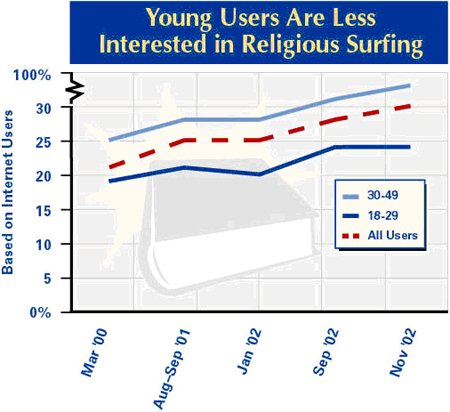
Other demographics
Religious surfers have generally become evenly represented across every educational and economic group. Yet, in our November 2002 survey economic variations were notable. The last time we polled this question, 34% of Internet users with a household income of less than $30,000 had sought religious information online, compared to 27% of those with an income of $75,000 or more who had done so.
We noted in 2001 that online experience did not correlate with higher levels of religious searching. However, our data from 2002 suggest that experience might have some connection to online religious surfing. In November, 19% of users with a year or less of experience online had searched for religious information, compared to 31% of those who had been online for 2-3 years. Further, those with 6 or more years of online experience were twice as likely to look for religious information compared to users who had been online for 1 year or less.
In a departure from a trend common among other information-seeking activities, having a high-speed connection does not increase the likelihood that a user will take faith-based inquiries to the Web. However, one finding that does fall in line with recurring trends is that parents search for religious content more than non-parents.
For more information on Americans’ pursuit of religious and spiritual information online, see the following Pew Internet Project reports:
-
CyberFaith: How Americans Pursue Religion Online https://www.pewresearch.org/internet/Reports/2001/CyberFaith-How-Americans-Pursue-Religion-Online.aspx
- Wired Churches, Wired Temples: Taking Congregations and Missions into Cyberspace https://www.pewresearch.org/internet/Reports/2000/Wired-Churches-Wired-Temples.aspx
More than half of users have logged onto government Web sites.
- 56% of Internet users have visited government Web sites as of November 2002.
- That represents 65% growth from 40 million who had accessed government Web sites as of March 2000, to 66 million in November 2002.
- The number of Americans who seek government information on a typical day online doubled (from 6 million to 12 million) between 2000 and 2002.
- A high percentage of Internet users aged 30-64 have used online government resources.
- Those with higher incomes and education levels are more likely to have used government sites compared to those with lower incomes and educational attainment.
- There is a greater incidence of seeking government information among users with home broadband connections and higher levels of experience online.
In November 2002, 56% of Internet users said they had visited a government Web site in search of information.37 That translated into approximately 66 million Americans who had accessed government resources online, up 65% from 40 million in March 2000. About 12 million online Americans (10% of all Internet users) were seeking information from government Web sites on a typical day in November 2002, up 100% from the 6 million (7% of all Internet users) who were doing so in March 2000.
There have been significant investments at the federal, state, and local level in developing e-government resources online and that effort is reflected in the corresponding growth of this activity in recent years. More Americans have sought information from government Web sites than have sought financial information online, made travel reservations, sent instant messages, or gotten sports information online. Furthermore, we have found that the vast majority of government Web site users are satisfied with what they find on the sites; 80% found what they were looking for during their last visit to a government site.38
Government Web site users take advantage of this new access to government with a multitude of personal, professional, and civic goals in mind. In our April 2002 report on e-citizens, the most frequently cited uses of these sites were: getting tourism and recreational information, doing research or work for school, downloading government forms, finding what services a government agency provides, and seeking information about public policy and other issues of interest. In addition to these information-seeking activities, many users have engaged in proactive efforts through these sites such as sending comments to government officials, filing taxes, and renewing licenses.
However, while the government continues to update and expand their online services, many Americans have yet to visit these sites and are still learning about what they might have to offer. While the most pronounced growth for this activity occurred between 2000 and 2001, the end of 2002 coincided with a lull in growth that fell in line with the stagnation of the online population.
For the first two years that we polled on this activity, men were far more likely than women to go online for government information. Yet the trend for 2002 suggests that there is now little difference in the number of men and women who use e-government resources.
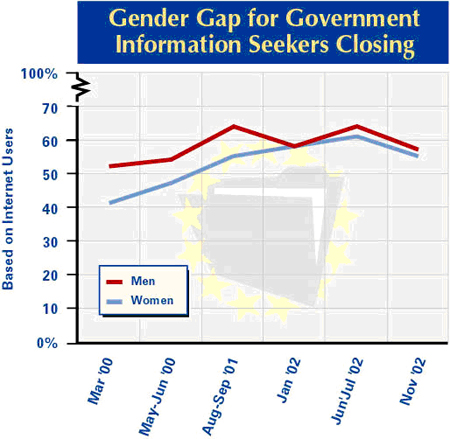
Overall, online whites have been more likely to say they have accessed government information on the Internet compared to online African-Americans and English-speaking Hispanics. There has been greater variation among those who visit government Web sites on a typical day, but our latest data showed that whites were also the most avid “daily” government information seekers. In November 2002, 11% of online whites sought government information on a typical day, compared to 4% of online African-Americans and 8% of online English-speaking Hispanics. And government information seeking is one activity where age clearly matters. Those who are 30-49 and 50-64 have time and again been the most eager to access e-government resources. Conversely, the youngest and oldest Internet users have been the least prone to be government Web site visitors.
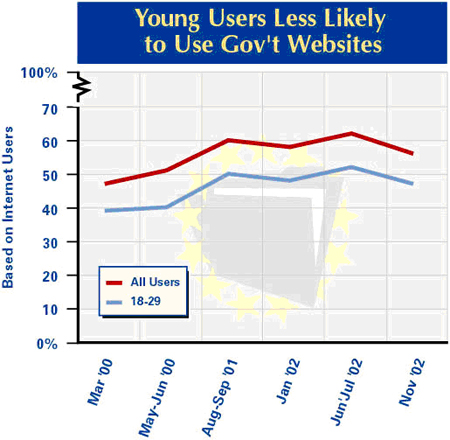
Other demographics
Internet users with higher education levels and those who live in households with higher incomes are more likely to seek information from government Web sites. This tendency has been evident since we first started polling on this activity in March 2000; however, since then, the education gap has lessened while the income gap has increased. A related factor to income and education, the more experience an Internet user has online, the greater the likelihood that he or she will have utilized e-government resources.
As with other information-seeking activities, those with high-speed Internet access at home and those who have more experience using the Internet are more likely to participate. In the November 2002 survey, 64% of home broadband users had searched for information on a government Web site and 56% of dial-up users had done so. Likewise, 48% of those with 2-3 years of experience online had tried visiting a government Web site for information, compared to just 30% of users who had been online for one year or less.
For more information on Americans’ use of government Web sites and information see the following Pew Internet Project reports:
-
Digital Town Hall: How Local Officials use the Internet https://www.pewresearch.org/internet/Reports/2002/Digital-Town-Hall.aspx
- The Rise of the E-Citizen: How People Use Government Agencies’ Web Sites https://www.pewresearch.org/internet/Reports/2002/The-Rise-of-the-ECitizen-How-People-Use-Government-Agencies-Web-Sites.aspx
- Dot-Gov Goes Retail https://www.pewresearch.org/internet/Reports/2001/Dotgov-Goes-Retail.aspx
The number of people who have looked for news or information about politics has increased by more than 50%.
- 40% of Internet users have looked for political information online as of November 2002.
- That represents growth of 57% from 30 million who reported getting political news and information in March 2000, to 47 million who reported such searches as of November 2002.
- More online men than women have used the Internet for political news and information.
- The largest proportions of political information seekers are in the highest education and income groups.
- Those with a lot of Internet experience and those with broadband connections are among the most likely to get political news and information online.
Searching for political news and information online has been a steadily expanding activity in recent years. Fueled by the overall maturation of the Internet audience, increased broadband penetration, and news events surrounding the 2000 and 2002 election seasons, the political information-seeking population grew by roughly 17 million Internet users between March 2000 and November 2002.39 In the same period, those who seek political information on a typical day grew from 9 million to 15 million.
During the 2002 elections, about four in ten Internet users said they had turned to the Web for political news and information. Their reasons for taking to the Web were varied, but, as we noted in our “Untuned Keyboards” report from March 2003, the most commonly cited reason (chosen by 49% of political information seekers) was convenience. Second to that, 37% of political information seekers said they looked online because they didn’t get the information they wanted from traditional news sources such as the daily newspaper or the network TV news. Once online and searching, the vast majority of these users want to find more information on candidates and their issues (64% of political-information seekers said this in November 2002).
However, the project has also found that these political-information seekers or “online citizens” are generally not satisfied with the yields of their searches. Compared to health information seekers and those who seek information from government agency Web sites, political information seekers are much less likely to say they found what they were looking for during recent searches.40
Male Internet users have time and again been more likely than female users to seek news and information about politics online. In November 2002, 43% of male users had turned to the Web for political content, while 36% of female users had done so. Likewise, the same trend applies for those who seek political information on a typical day.
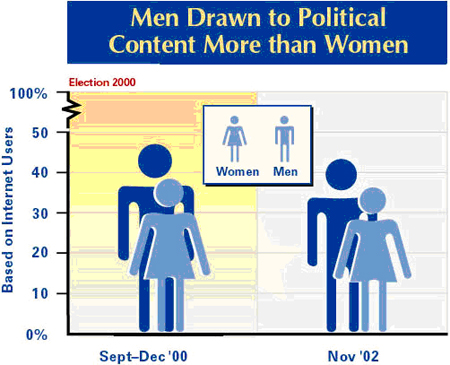
Whites, English-speaking Hispanics, and African-American Internet users have often been equally as likely to say they seek political information on the Web. However, in our November 2002 sample, during the last election season, 42% of online whites said they had searched for political news or information, while just 34% African-American users and 29% of online English-speaking Hispanics said so.
There has not been great variation among the different age groups of Internet users for this activity, but young adults (18-29) tend to be less likely to be political information seekers. This is most apparent among those who are likely to search for political information on a typical day. In November 9% of all wired 18- to 29-year-olds sought political content the day prior to the survey, while 15% of wired 30- to 49-year-olds did so.
Other demographics
Internet users who have graduated college have been more likely to follow politics online than those who don’t hold a college degree. However, the difference across income groups has been less apparent — only those Internet users in the highest income bracket (households earning $75,000 or more per year) have been markedly more likely to search for political content online than other online Americans.
The more experienced the Internet user, the more likely he or she is to search for political information on the Web. Users with three or more years of experience online take to the Web for political content in much higher numbers compared to newer users. Last election season, users with just 2-3 years of experience online were twice as likely to seek political content compared to those with 1 year or less under their belt (29% vs. 14%).
Those who have high-speed Internet connections at home are also more likely to delve into political content while online. For example, in our November 2002 survey, 51% of broadband users had sought political content, while 38% of dial-up users had done so.
For more information on how Americans use the Internet to gather political information, see the following Pew Internet Project reports:
- Untuned Keyboards: Online Campaigners, Citizens and Portals in the 2002 Elections https://www.pewresearch.org/internet/Reports/2003/Online-campaigners-citizens-and-portals-in-the-2002-elections.aspx
- Modest Increase in Internet Use for Campaign 2002 https://www.pewresearch.org/internet/Reports/2003/Modest-increase-in-Internet-use-for-campaign-2002.aspx
- Internet Election News Audience Seeks Convenience, Familiar Names https://www.pewresearch.org/internet/Reports/2000/Internet-Election-News-Audience-Seeks-Convenience-Familiar-Names.aspx
More than half of Internet users have done research for school or training.
- 53% of Internet users have done research for school or training online as of September 2002.
- That represents growth of 34% from 47 million who said they had done this kind of research online as of March 2000, to 63 million Americans who reported doing this as of September 2002.
- A higher proportion of minority Internet users than whites have done research for school or training.
- Young adults are much more likely than older Internet users to have done this type of research online.
- There is a higher incidence of doing online research for school or training among those with the most education and experience online.
At any given time when we ask Americans about this activity, over half of all Internet users say they use the Web to do research for school or training. In March 2000, this meant that about 47 million Americans were logging on to get information related to their education. And by September 2002, after the online population had swelled to 61%, we could estimate that there were approximately 63 million Americans using the Internet for school or training research. That is more than did research for their job or got financial information online during that period, but is still less than those who got health information or who had bought a product online. In a related finding, as of our March–May 2002 survey, 7% of Internet users had taken a course online for college credit, and 6% had taken some other type of online course.
About one in ten online Americans report use of the Web for educational research on a typical day. This has remained consistent throughout our surveys. In March 2000 that translated to 9 million users, while an average day in September 2002 saw 12 million users taking to the Web in search of information relevant to their educational pursuits. As we have found in our past research, students now rely heavily on the Internet to help them do their schoolwork, some teachers use the Web to facilitate their instruction, and others use the Web in conjunction with continuing education courses or job-related training. Computers with Internet connections are now commonplace in many American classrooms and some teachers now require some form of online participation from their students.
The amount of educational material available to students on the Web is monumental. Libraries have invested vast amounts of time and resources to making catalogs, documents, and research tools available online. Universities’ Web sites have contributed an enormous body of knowledge in the form of digital archiving projects, online research initiatives, discussion lists, and blogs to name a few. In addition, government and non-profit Web sites, health, commerce, media, entertainment, personal sites, etc. all contribute to the wealth of knowledge available for those researching on the Web.
At the same time, though, many of the most tech-savvy teens complain that the resources and teaching aids available on the Web are not well-understood or well-used in most classrooms. The majority of educational Web use by teen-aged students occurs outside of the classroom.41
Our data has consistently shown that minority users are more likely to use the Internet for research related to their education compared to whites. In our report on African-Americans and the Internet based on data gathered March–August 2000, we found that online blacks were 20% more likely than online whites to have conducted school research or training on the Web.42 Our September 2002 survey further confirmed this finding; online blacks were 24% more likely than whites to do this type of educational research (63% vs. 51%).
Online English-speaking Hispanics’ use of the Web for school and training has also repeatedly been higher than online whites’ usage. Data from surveys conducted March–December 2000 show that 61% of Hispanic Internet users had done research for school while just 51% of white users had done so.43 In September 2002, a slightly smaller portion of online Hispanics, (56%) reported use of the Web for school research, while online whites remained at 51%.44
In addition, we have found that Asian American users are considerably more likely to have conducted school or training-related research compared to whites. When data from March–December 2000 was combined to yield a group of 486 English-speaking Asian American respondents (who typically constitute a very small portion of our sample during each survey period), we found that 68% of Asian-American Internet users had used the Web to do educational research, compared to 51% of white users.45 Asian-American users were also twice as likely as white, English-speaking Hispanic, and African-American users to conduct research for their school or training on an average day.
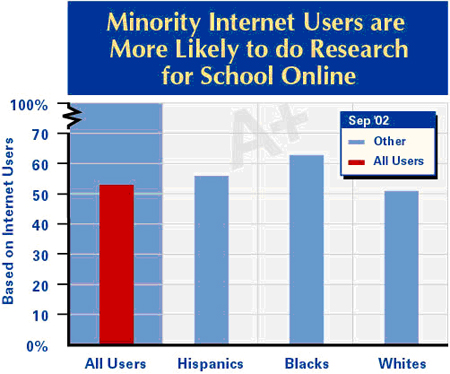
Considering that the majority of American adults who are enrolled in school or other classes are between the ages of 18 and 29, it is understandable that this segment of the online population is also far and away the most likely to do research for school on the Internet. About 7 in 10 Internet users between the ages of 18 and 29 say they have used the Web to find information for school at any given time when we ask this question. The likelihood that an Internet user will use the Web to do research for school or training decreases with age, a trend that is also evident among those who conduct education-based research on a typical day. In September 2002, just 53% of wired 30- to 49-year-olds were seeking information for school online, compared to 70% of users aged 18-29.
Other demographics
There has not been great variation among users with different income levels who conduct research related to their education online. On the other hand, a user’s education level might have some bearing; users in our September 2002 survey who had at least some college education were more likely to turn to the Web to do research for school. Comparatively, that marks a shift from some of our earlier findings; in the fall of 2000, for example, users with less than a high school education and those with college degrees were equally as likely to have done research online.
The longer a user has been online, the more likely he is to use the Web for school or training research. In September 2002, users who had been online for at least 4 years were more than twice as likely to carry out educational research online compared to those who had only 1 year of Internet experience.
Many students have access to a high-speed Internet connection through their schools or training centers, so it is not surprising that the home broadband factor does not weigh as heavily with this information-gathering activity. In September 2002, 57% of online Americans with high-speed connections at home reported taking to the Web for school-related research and 52% of dial-up users did so.
For more information on how Americans use the Internet for school, see the following Pew Internet Project reports:
- College Students and the Web https://www.pewresearch.org/internet/Reports/2002/College-Students-and-the-Web.aspx
- The Internet Goes to College: How Students are Living in the Future With Today’s Technology https://www.pewresearch.org/internet/Reports/2002/The-Internet-Goes-to-College.aspx
- The Digital Disconnect: The Widening Gap Between Internet-Savvy Students and Their Schools https://www.pewresearch.org/internet/Reports/2002/The-Digital-Disconnect-The-widening-gap-between-Internetsavvy-students-and-their-schools.aspx
- The Internet and Education https://www.pewresearch.org/internet/Reports/2001/The-Internet-and-Education.aspx
About half of online Americans have done work-related research online.
- 52% of Internet users say they have done research for their job online as of November 2002.
- That represents growth of 45% from 42 million who reported doing work research in March 2000, to 61 million Americans who reported such online activity in November 2002.
- The higher the household income and the higher the user’s education level, the more likely it is that she has done job-related research online.
- Those with the most experience online and those with broadband connections are more likely than others to do work-related research online.
As more and more Americans gain the capability to go online from both their home and their workplace, an increasing number are performing some of their job-related tasks with the help of the Internet. The proportion of the online population that has used the Web for work has not changed dramatically during the period of our research. About half of all Internet users had done work-related research online at any given period between 2000 and 2002. In March of 2000, the 49% of Internet users who said they had done work online equaled approximately 42 million Americans. But the last time we asked about this activity in November 2002, taking the overall growth of the online population into account, the 52% of Internet users who had used the Web for work equaled roughly 61 million Americans. On a typical day online, the number of Internet users doing work or research for their job grew from 14 million in March 2000 (16% of all Internet users) to 22 million in November 2002 (19% of all Internet users).
With the increased popularity of telecommuting and the advent of wireless Internet technologies, online work and research for one’s job can potentially take place just about anywhere. However, as we reported in our longitudinal study in March 2002, a modest number of Internet users — one in seven — said their use of the Internet resulted in an increase in the amount of time they spent working at home. One in ten said the Internet actually increased the time they spent working at the office.46
Male Internet users report doing job-related research and other work online in greater proportions than female Internet users. This is possibly related to the greater percentage of men in the workforce, as reflected in our sample. Also, we have found that male Internet users are more likely to say they go online from their workplace. However, there have been considerable variations in job-related research gap over the course of our studies. In November 2002, the difference was slight; 54% of male users did work or research for their job compared to 50% of female users.
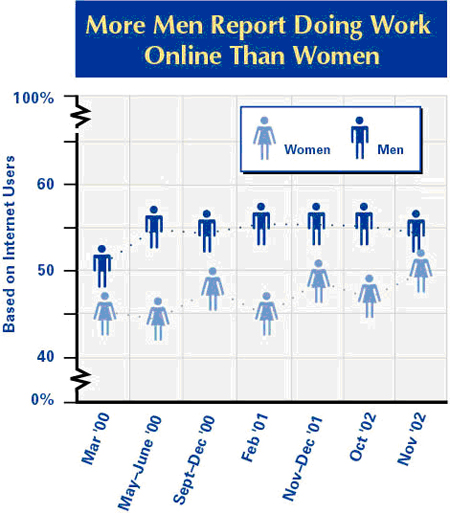
African-American Internet users are the least likely to say they have used the Web for work activities. However, this hasn’t always been the case; in 2000, in particular, there were only marginal differences between the various racial groups of Internet users when it came to doing work online. But when we last asked this question in November 2002, only 41% of online blacks said they had done this activity, compared to 53% of both the white and English-speaking Hispanic groups of Internet users.
While the lives of young adults tend to be extremely saturated with new technologies, many of them are still in school or not yet immersed in the type of working environment that might require the use of the Internet. Therefore, it is not surprising that we have found these youngest users are the least likely to say they use the Web for purposes related to their job. Conversely, the next demographic age bracket, 30- to 49-year-olds, have the highest proportion of those who say they use the Internet for work-related tasks.
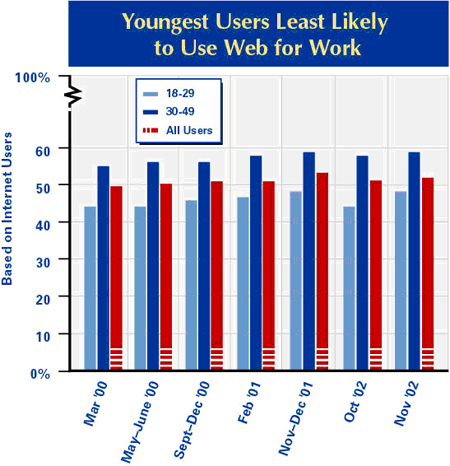
Other demographics
Not surprisingly, those with higher levels of education and income have consistently been more likely to use the Web for work. For example, in November 2002, 75% of those with at least a college degree had done work online, while only 37% of those with a high school education had done so. Forty-three percent of Internet users with an annual household income of less than $30,000 used the Web for their job during this period, compared to 67% of those with incomes of $75,000 or more.
Those with the most experience online and those with broadband connections are more likely than others to do work-related research online. In November, Internet users with 4-5 years of experience were twice as likely to use the Web for work as those who have been online for 1 year or less. In that same period, 65% of broadband users were doing work online compared to just 48% of dial-up users.
For more information on how Americans use the Internet at work, see the following Pew Internet Project reports:
- Email at Work: Few feel overwhelmed and most are pleased with the way email helps them do their jobs https://www.pewresearch.org/internet/Reports/2002/Email-at-work.aspx
- Wired Workers: Who They Are and What They’re Doing Online https://www.pewresearch.org/internet/Reports/2000/Wired-Workers.aspx




